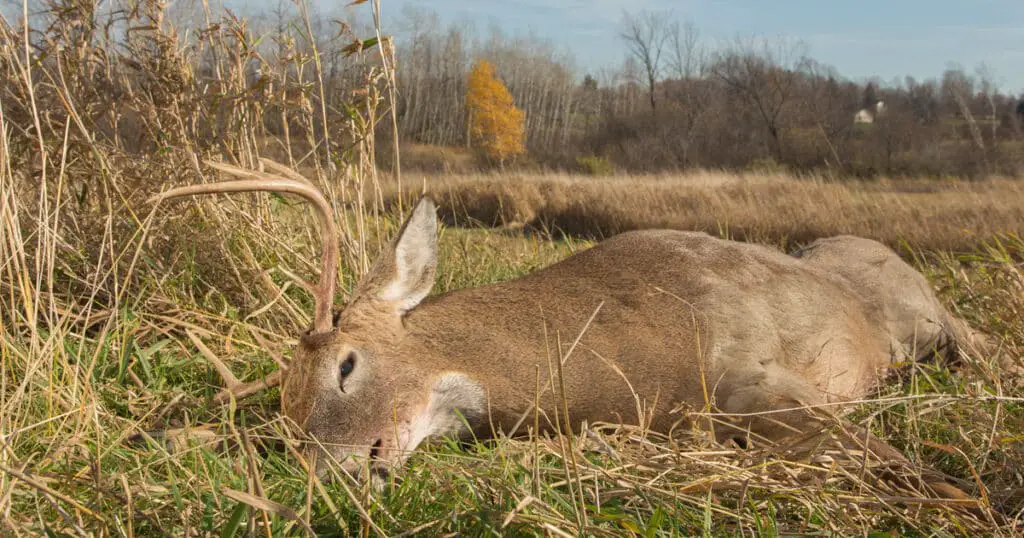Have you ever been out hunting or on a nature walk and come across a pair of antlers floating in the water, quickly realizing that there was an entire deer attached? It’s a pretty puzzling and startling sight. Surely, deer know when the water is too cold or deep, right? Often, this phenomenon of deer dying in water is caused by a deer disease called EHD (Epizootic Hemorrhagic Disease). Keep reading to learn about EHD in deer.
Epizootic hemorrhagic disease, otherwise known as EHD (and sometimes called just hemorrhagic disease) is an often-fatal viral disease. It’s primarily found in whitetail deer, but sometimes also appears in other ruminant species. It can run rampant in a herd, leaving does and bucks floating along streams and winding up on the shores of a river.

This disease causes hemorrhaging of the deer’s lungs and heart. But why does this disease cause them to end up dead and floating in the water? Let’s find out more.
In this article, we’ll discuss:
- What is EHD?
- Causes of EHD
- Origin of EHD
- Species affected by EHD
- EHD signs and symptoms
- Epidemiology
- Treatment methods
- What are we doing about EHD?
- EHD mortality and significance
- Frequently asked questions about EHD
What is EHD?
EHD (Epizootic Hemorrhagic Disease) is a hemorrhagic deer disease. An infectious virus causes it, and it’s a frequently fatal condition. The virus primarily affects the population of white-tailed deer in North America, and due to its severe effects and rapid spread, it can quickly decimate an affected deer herd.
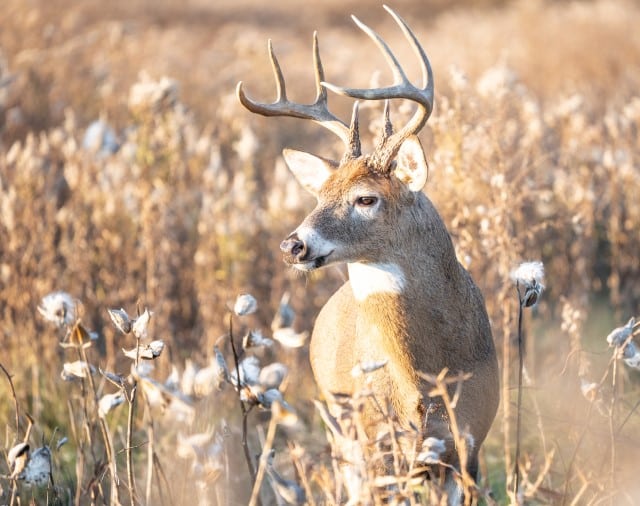
This migratory virus is an endemic enemy. This means it may be common in particular groups.
Presently, the most severely impacted deer are wild populations of white-tailed deer in North America. It has never been found to affect domesticated species, though similar viral infections do affect domestic ruminants.
This virus can cause significant mortality events, and there have been matching antibodies found within sheep, cattle, and even pigs.
Causes of EHD
Epizootic hemorrhagic disease (EHD) is a quick circulating disease that we understand little about. It took many years for professionals to finally figure out what would cause such a catastrophic event and find answers about a fly smaller than a grain of salt.
These flies, otherwise known as gnats or small midges, are responsible for infecting the deer by biting their host while carrying the virus and then moving on to another member of the herd.
Origin of EHD
Some scientists trace the first case of this disease back to the 1880s or 90s. It has been a leading cause of die-offs of many species across the North American landscape.
Experts once believed that diseases such as blackleg (a bacterial infection) or mycotic stomatitis (mucous membrane inflammation) were the cause for many of these die-offs. However, scientists have since found there wasn’t a bacterial agent.
This suggests that EHD probably caused most of these cases.
Species Affected By EHD
EHD occurs primarily in white tailed deer (Odocoileus virginianus).
However, it can also occasionally occur in mule deer, pronghorn antelope, bighorn sheep, and exotic ruminants. In those species, however, only a few cases have occurred in the past decade.
EHD Signs and Symptoms
There are many warning signs and symptoms of EHD in white-tailed deer.
Because there are as many internal issues as there are external symptoms, we’ve decided to break this section off into those two categories.
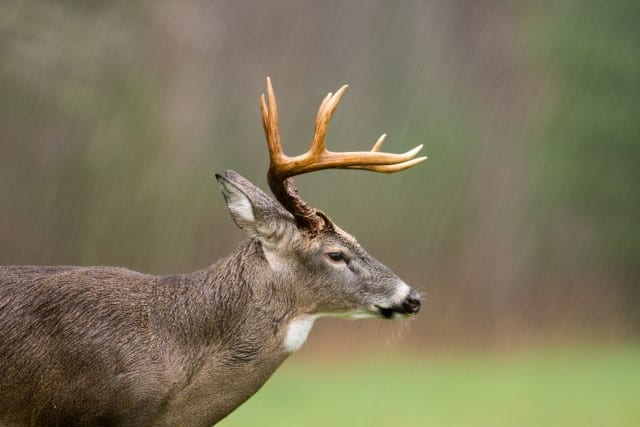
Internal Symptoms of EHD in Deer
- A mild to high fever that causes deer to look for cool spots while also quenching their thirst due to profoundly severe hydration (for example, in and around water).When deer jump in the water, they often find they lack the strength to use their legs. Exhaustion usually results in drowning.
- Interior organs will begin shutting down, undoubtedly influencing the heart, liver, spleen, kidney, lungs, and digestive system.
- The liver, spleen, and lymph hubs may get enlarged and clogged.
- Sores or ulcers may develop on the lips, tongue, and cheeks.
External Symptoms of EHD in Deer
- Exhaustion and lack of wariness about surroundings
- Dehydration and lack of appetite
- Heavy breathing
- Extreme drooling
- The mouth and tongue appear to be blue
- Blood specks might happen in the pee and dung
- In severe cases, bleeding will occur in loose stool
- May show weakness and choose to keep away from direct daylight.
When many members of a herd die from EHD, they tend to be found in or close to open water.
Clinical Signs
A whitetail deer suffering the clinical condition of EHD can show symptoms ranging from acute illness, which is fatal within less than 38 hours, to a chronic issue that can last well over a few months.
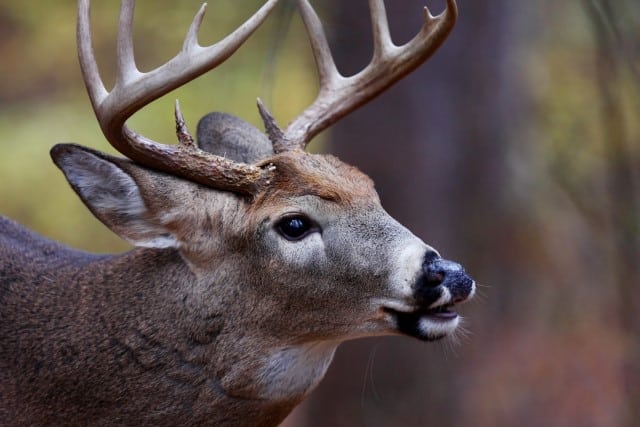
If the elements and surrounding environment didn’t also play a role in the recovery or demise of these animals, there would be no doubt their bodies could survive longer than a month in paralyzing critical condition.
Deer with the EHD virus sometimes won’t have any symptoms. Others, on the other hand, present the full-fledged symptoms of loss of appetite, emaciation, fever, convulsions, lethargy, stiffness, and respiratory distress.
Here are some clinical signs that have been observed in deer with EHD that could be closely accessed:
- Swelling of the mucus membranes and palate, leading to congestion of the salivary glands and resulting in large amounts of drooling (possibly blood-tinged)
- Inflammation of the conjunctiva that may result in oral ulcers and erosions
- Diarrhea
- Dehydration, which is the main reason we often find the deer carcasses near bodies of water (as well as moderate irregularities in blood samples as the cells begin to merge and thicken)
- The creatures that endure for a longer period of time will usually show obvious signs of lethargy and emaciation,
- Other signs of long infection are rings in the hooves being broken due to growth interruptions, which results in lameness (this is why some of the deer are seen crawling on their chest or knees)
- In severe lengthy cases, the animals slough the hoof or wall toe resulting in nearly complete immobilization
Epidemiology
EHD outbreaks are generally related to seasonal patterns and weather changes. They usually start around the late summer months and into early fall.
Cold winter weather will kill the flies and the virus within two weeks. Luckily, this limits the transmission cycle.
While the EHD virus hasn’t been found in all areas, it can travel. Wind currents and global warming may lead to EHD appearing in new places.
Treatment Methods
Currently, we don’t have an effective treatment developed to control or treat the EHD virus.
We hope that future technological advancements will bring us closer every day to a theoretical oral vaccine. Some scientists believe one day they can give deer this vaccine via a winter round-up and feeding program.
What Are We Doing About EHD?
At the moment, we don’t have a method of completely preventing the population damage done by EHD on an almost annual basis.
But that doesn’t mean we can’t do anything to help. Many ministries and resource groups need the public’s assistance to help monitor EHD in multiple northern areas.

Because it’s such a hard-hitting disease that affects deer on an annual basis, even if it is on a smaller scale, it can be difficult for the ministry to determine if the reports are due to a significant outbreak or not.
That’s why some organizations ask the general public to report whenever a deer carcass has been found so that they can enter the data in their system.
Once it’s in the system, the ministry can begin building a baseline level of EHD in the zone to help determine if a large outbreak is happening to observe and move herd members away from said area.
Because midge larvae develop on water, you can actually help by eliminating standing water in items such as buckets, containers, and old tires. If you have any bird baths, you should change the water regularly.
Overall, this can help reduce the number of biting bugs responsible for the spread of EHD.
Mortality and Significance
Because of how high the mortality rate is, EHD can significantly affect the deer population within a given region, drastically reducing the numbers in a minimal time of four days or less.
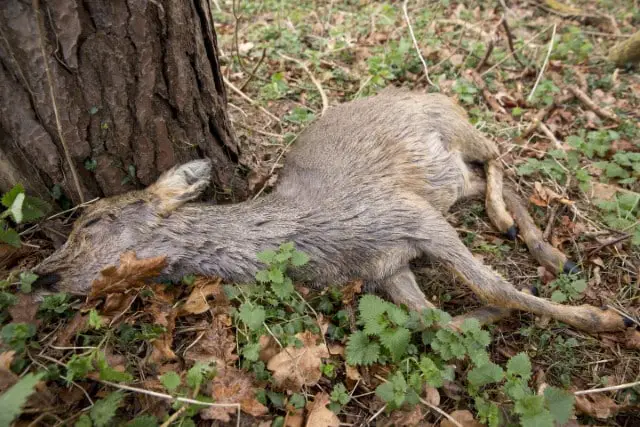
A common observation seen in outbreaks involving vast numbers of deer is that they are epizootics only once.
Die-offs that result in a small number of deaths usually occur annually. In regions where this happens, the disease appears almost enzootic.
This means that it can be transferred to other wild ruminants, which can quickly damage the ecosystem.
Frequently Asked Questions
While we’ve thoroughly covered the topic of the EHD virus in Deer in this article, you probably still have some questions. That’s why we’ve included the FAQs section below.
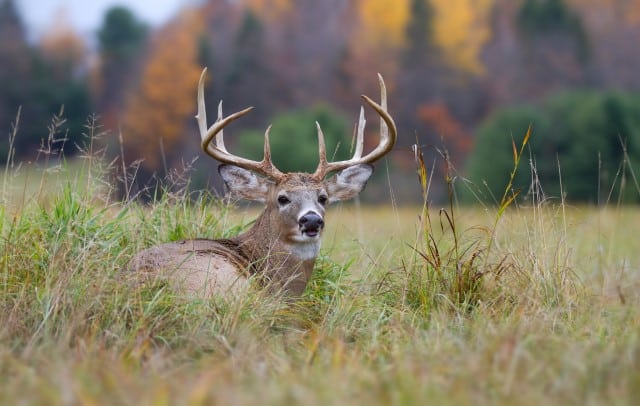
What causes EHD in deer?
EHD (Epizootic Hemorrhagic Disease) is caused by the EHD virus. Gnats smaller than the average mosquito transmit this fatal disease.
What are the symptoms of EHD?
As listed above, the symptoms of EHD include:
- Loss of appetite
- Anorexia
- Swelling around the face, head, or neck
- Excessive salivation
- Cracked hooves and a hard time walking
- Panting
- Struggle to stand (in acute cases could lead to flailing of the head and convulsing before death)
- Dehydration and overall weakness
Is EHD contagious?
EHD cases can and have been found all around the northern hemisphere in the United States and Canada.

Although it is a locally contagious virus, the spread is usually contained during the winter months as insects start disappearing when the cold wind starts blowing, which stops the spread.
How is EHD spread in deer?
Midges spread EHD. Midges are flies that we find in the northern hemisphere.
They’re tiny, just about the size of a grain of salt. They infect their hosts by biting them and moving on to the next susceptible host.
Is EHD the same as chronic wasting disease in deer?
No, CWD or “Zombie Deer Disease” is a very different disease than EHD. The infection that causes CDW is an abnormal protein otherwise known as a prion, while EHD affects its host virally and attacks the living cells of the animal. It also has different symptoms.
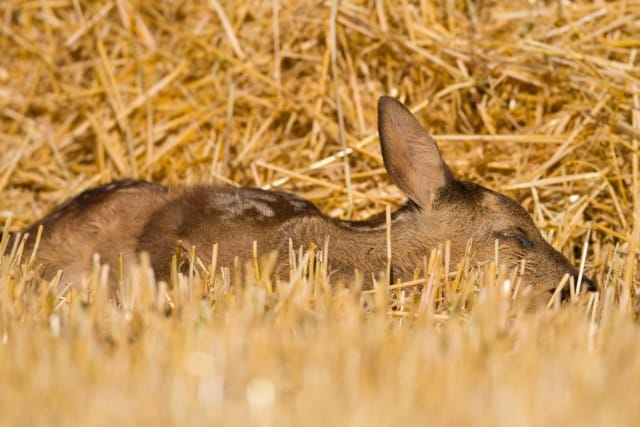
Can a deer survive EHD?
One of the most common characteristics we see with EHD is that the chronic form leads to the deer having hooves that are either cracked or sloughing.
Although it might seem impossible as the animals stay quite ill for several weeks, they can recover from EHD.
Why do deer with EHD go to the water?
Deer infected with EHD go to the water because of how dehydrated and exhausted they are. They want to drink the water and get in it to cool off from their fever.

The deer will jump into the water, where they will eventually drown due to their system shutting down and being unable to keep their head above the water.
Can you eat a deer that has EHD?
According to the Government of Ontario (in Canada), it may be safe to eat meat from an infected deer but only if there aren’t any signs of illness, abscesses, and ulcers. Here’s exactly what they say below:
“Eating meat from EHD -infected deer that is free from signs of sickness, ulcers, abscess, or other abnormalities is considered safe.”
– Government of Ontario (source)
What to do if you find a dead deer?
You should notify the closest wildlife authorities if you find a dead deer. They will come and collect the animal.
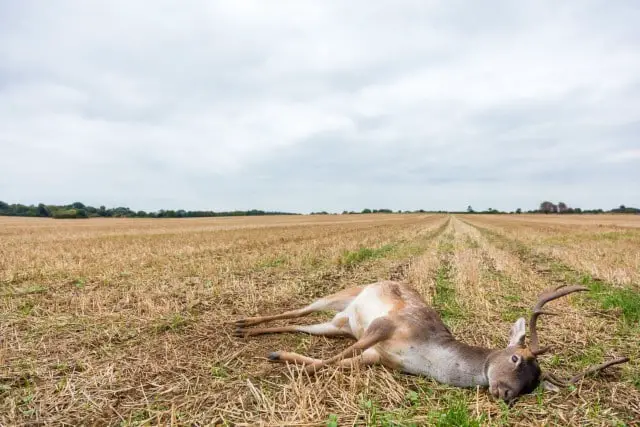
It’s best if you do not touch it with your bare hands as you don’t know if the animal is either poached or if an autopsy is needed. You don’t want to contaminate the animal or collect germs on your hands.
How do I protect myself and others?
The EHD virus does not affect humans, so at present there is no need to worry about contracting this disease through a bug bite.
Can EHD affect other wildlife?
Yes, EHD can eventually affect other ruminant species and even has a few times before. The only difference is a deer’s body is intrinsically more susceptible to this viral infection to the point where they can’t fight it off as well as some other species can.
Do drought/hot temperatures cause EHD?
No, drought and heat cannot cause EHD. Instead, a virus carried by insects leads to this disease.
However, the symptoms of this disease will be worse and more dangerous if a deer cannot find drinking water.
When do EHD outbreaks occur?
EHD outbreaks usually occur in late summer to early fall as that is generally when bug season is at its peak.
How can I tell if a deer I hunted survived EHD?
If you cull a deer during the hunting season, always pay attention to the animal’s hooves, as deer who survive the outbreak tend to have lesions on their legs and cracks forming around the foot.
Sloughing or splits in the hooves on more than one foot of a deer killed during the fall season are typically positive for once having chronic EHD.
Final Thoughts: EHD in Deer
Let’s review the most important facts we’ve learned about EHD (Epizootic Hemorrhagic Disease) in deer:
- EHD is primarily found in white-tailed deer in North America.
- This disease is caused by a virus that insects (midges) spread.
- While EHD tends to be fatal, some deer survive this disease.
- Dehydration and fever are common EHD systems. This is why affected deer enter the water and end up drowning from exhaustion.
Further Reading on the Subject
- Michigan Department of Natural Resources. Wildlife Disease. Epizootic hemorrhagic disease (EHD) in white-tailed deer. http://www.michigan.gov/dnr/0,1607,7-153-10370_12150_12220-26647–,00.html.
- “Epizootic Hemorrhagic Disease – Iowa State University.” Epizootic Hemorrhagic Disease.pdf, Dec. 2016, https://www.cfsph.iastate.edu/Factsheets/pdfs/epizootic_hemorrhagic_disease.pdf.
- Ministry of Natural Resources. Epizootic Hemorrhagic Disease in British Columbia Wildlife … https://www2.gov.bc.ca/assets/gov/environment/plants-animals-and-ecosystems/wildlife-wildlife-habitat/wildlife-health/wildlife-health-documents/epizootic_hemorrhagic_disease.pdf.

